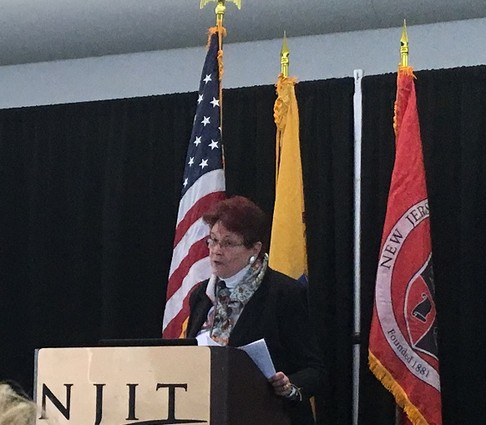Steffen-Fluhr Addresses the Gender Gap for Women in Tech at NJ-Israel Commission Event

At a New Jersey-Israel Commission event at New Jersey Institute of Technology (NJIT) on December 15, Dr. Nancy Steffen-Fluhr, director of the Murray Center for Women in Technology, discussed NJIT’s view of the digital divide as it applies to women. She also described the Murray Center’s efforts to overcome the gender gap in tech.
The event was called “Can We Overcome the Digital Divide?” It offered several viewpoints on this issue and compared New Jersey’s obstacles with Israel’s own deficiencies.
“If the United States and its allies are to succeed in creating a robust technology workforce in the future, we will have to dramatically increase the number of women in tech fields,” Steffen-Fluhr began.
She acknowledged the many attempts to close the gender gap by players in the marketplace, but showed how they fell short. “We know that biodiversity makes for a more resilient ecosystem, and the same principle applies” to technology.
Why, she asked, is a “technologically adept girl seen as an exception that proves the rule?” A young girl shouldn’t have to prove that she is good in technology, Stephen-Fluhr said. “Not every girl wants to swim upstream just to prove that she can.”
The current theory is that while girls can do STEM subjects, they don’t believe they can, so they tend to choose non-STEM majors and careers. People are trying to change this self-deprecating belief system in girls, so that they’ll have the confidence to enter STEM fields.
“It’s hard to argue that this isn’t important. If we don’t believe we can do something, we are pretty much stymied at the start. Yet changing this begins with the idea that there is something wrong with women and girls and the choices they make,” she said. “This is an assumption I believe we ought to question.”
Research from Apple has shown that girls tend to look right through a machine to focus on its social function, said Steffen-Fluhr. They care about what computing is good for, about social problems and science in context. In short, girls like “computing with a purpose,” she noted. The trick is to show that technology gives value to the many interests girls already have.
NJIT is working to show girls and young women the opportunities in tech that can address their concerns. For example, a conference on “Women Defining the Future” discussed fields at the intersection of design and technology. The keynote speaker, Danielle Feinberg, director of photography for lighting at Pixar Animation Studios, described how she applied her expertise to the amazing visual representations seen in animated movies such as Toy Story 2 and Monsters, Inc.
Also this summer, NJIT hosted a seven-week Girls Who Code emersion program. “I think this is a game changer among several recent efforts that offer a bridge over the digital divide,” said Steffen-Fluhr. Some 40 high school students from around New Jersey learned about such areas as robotics and mobile app development, while gaining inspiration from high-tech industry mentors and folks in the business.
Two hands-on workshops were worth mentioning, Steffen-Fluhr noted. In one, Martina Decker, professor at NJIT’s College of Architecture and Design, worked with the girls to build kinesthetic assemblies using shape memory alloys, which are smart materials that can be used to design things like reactive dresses and energy-saving architectural façades, she said.
In another workshop, a professor took the girls on a tour of a biomedical engineering lab where tools such as robotics and gaming technology were being used to rehabilitate people with disabilities.
“This allowed the young women to see through the machine to its social function and creative possibilities,” Steffen-Fluhr concluded. “It is this ‘X-ray vision’ that will fundamentally alter the gender distribution in the high tech sector over the next 25 years, a sea change that will, in turn, fundamentally enhance our collective capacity for innovation.”

